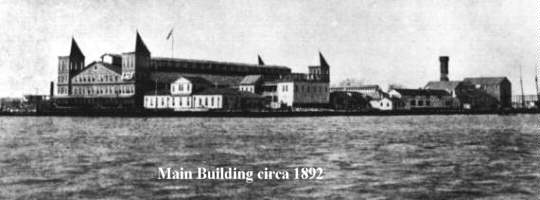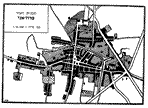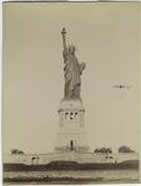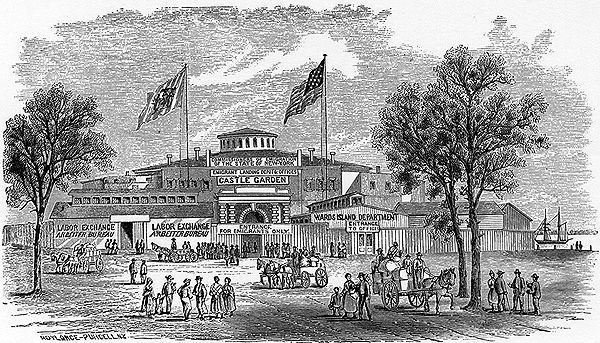IMMIGRATION
The New Colossus
-
Not like the brazen giant of Greek fame,
-
With conquering limbs astride from land to land;
-
Here at our sea-washed, sunset gates shall stand
-
A mighty woman with a torch, whose flame
-
Is the imprisoned lightning, and her name
-
Mother of Exiles. From her beacon-hand
-
Glows world-wide welcome; her mild eyes command
-
The air-bridged harbor that twin cities frame,
-
"Keep, ancient lands, your storied pomp!" cries she
-
With silent lips. "Give me your tired, your poor,
-
Your huddled masses yearning to breathe free,
-
The wretched refuse of your teeming shore,
-
Send these, the homeless, tempest-tossed to me,
-
I lift my lamp beside the golden door!"
Emma Lazarus, New York City, 1883
Below are modifed excerpts from the Ellis Island American Immigration Family History Center website.
Between 1880 and 1930 over twenty-seven million people entered the United States, about twenty million of whom entered through Ellis Island. By the 1880's, steam power had shortened the journey to America dramatically. Immigrants poured in from around the world: from the Middle East, the Mediterranean, Southern and Eastern Europe, and down from Canada.
In the United States they hoped to begin life anew--a life filled with opportunities to better themselves within a society that would allow them to enjoy greater religious, economic and political freedoms than they had ever experienced before.

Castle Gardens
Castle Gardens (now called Castle Clinton, after Mayor DeWitt Clinton) was an old fort built to protect the harbor of New York. It was renovated and reopened as a New York State Immigration Reception Center on August 1, 1855.
Ships anchored at a quarantine station six miles below New York City, where an emigration boarding officer boarded to count passengers, ascertain the number of deaths during the voyage, the degree and kinds of illnesses suffered during the voyage, and the overall cleanliness of the vessel. After sending a report to the general agent and superintendent at Castle Garden, the boarding officer remained on the ship as it steamed up to anchor near the Castle Garden depot.
Passengers then were transferred to the jurisdiction of the Landing Department. Following a customs inspection of luggage, immigrants and their belongings were taken by tugs and barges to the Castle Garden depot. They then underwent medical examinations to determine if there were any sick people overlooked by the boarding officer's examination and to select others subject to "'special bonds under the law," such as "blind persons, cripples, lunatics, or any others who are likely to become a future charge." After examination, the immigrants were directed to a rotunda in the center of the depot for registration of their names, nationalities, former residences, and intended destinations.
If an immigrant was denied entry, the shipping line that brought them had to transport them back to where they came from at the shipping line's expense. To avoid being sent back, immigrants were coached on giving answers. If they were coming to join a family member or relative, their chances of being allowed to enter the USA were much better than if they were not related to anyone in the USA. Consequently, the name and address of who they were going to join is not always confirmation of a relationship.
Before 1890, individual states rather than the Federal government, regulated immigration into the United States. Castle Gardens in the Battery served as New York State's immigration station from 1855 to 1890. About eight million immigrants, mostly from Northern and Western Europe, passed through its doors. The early immigrants were mostly from England, Ireland, Germany and the Scandinavian countries. Throughout the 1800's and intensifying in the latter half of the 19th century, ensuing political instability, restrictive religious laws and deteriorating economic conditions in Europe fueedl the largest mass human migration in the history of the world. It soon became apparent that Castle Gardens was ill-equipped and unprepared to handle the growing numbers of immigrants arriving every year. Unfortunately, compounding the problems of the small facility, corruption and incompetence were commonplace at Castle Gardens.
Ellis Island

The Federal government intervened and constructed its own immigration station on Ellis Island in New York harbor. Over the years, Ellis Island has grown from 3.3 acres to 27.5 acres, most of the landfill coming from ship ballast and earth carted away from the construction of the New York City subway. The new structure on Ellis Island, built of "Georgia pine" opened on January 1, 1892. Annie Moore, a 15 year-old Irish girl, accompanied by her two brothers, entered history and a new country as she was the very first immigrant to be processed at Ellis Island on January 2nd. Over the next sixty-two years, more than twelve million were to follow her through this port of entry.
From 1892 to 1954, over twelve million immigrants entered the United States through the portal of Ellis Island, a small island in New York Harbor. Ellis Island is located in the upper bay just off the New Jersey coast, within the shadow of the Statue of Liberty. Through the years, this gateway to the new world was enlarged from its original 3.3 acres to 27.5 acres mostly by landfill obtained from ship ballast and possibly excess earth from the construction of the New York City subway system.
During the evening of June 14, 1897, a fire on Ellis Island burned the immigration station completely to the ground. Although no lives were lost, many years of Federal and State immigration records dating back to 1855 burned along with the pine buildings that failed to protect them. The United States Treasury quickly ordered the immigration facility be replaced under one very important condition. All future structures built on Ellis Island had to be fireproof. On December 17, 1900, the new Main Building was opened and 2,251 immigrants were received that day.
THE IMMIGRANT EXPERIENCE
While most immigrants entered the United States through New York Harbor, the most popular destination of steamship companies, many sailed into other ports such as Boston, Philadelphia, Baltimore, San Francisco and Savannah, Miami, and New Orleans. The great steamship companies, such as White Star, Red Star, Cunard and Hamburg-America, played a significant role in the history of Ellis Island and immigration in general. First and second class passengers who arrived in New York Harbor were not required to undergo the inspection process at Ellis Island. Instead, they underwent a cursory inspection aboard ship because it was thought that those who could afford to purchase a first or second class ticket, were less likely to become a public charge in America for medical or legal reasons. The federal government believed these more affluent passengers would not end up in institutions or hospitals or become a burden to the state. However, first and second class passengers were sent to Ellis Island for further inspection if they were sick or had legal problems.
This scenario was far different for steerage, or third class passengers. They traveled in crowded and often unsanitary conditions near the bottom of steamships. There were few amenities. They could spend up to two weeks seasick in their bunks during rough Atlantic Ocean crossings. Upon arrival in New York City, ships would dock at the Hudson or East River piers. First and second class passengers would disembark, pass through Customs at the piers and enter the United States. The steerage and third class passengers were transported from the pier by ferry or barge to Ellis Island, where everyone would undergo a medical and legal inspection.
If the immigrant's papers were in order and the person was in reasonably good health, the Ellis Island inspection process would last approximately three to five hours. The inspections took place in the Registry Room. or Great Hall, where doctors would briefly scan every immigrant for obvious physical ailments. Doctors at Ellis Island soon became very adept at conducting these "six second physicals." By 1916, it was said that a doctor could identify numerous medical conditions ranging from anemia to goiters to varicose veins just by glancing at an immigrant. The ship's manifest log, filled out back at the port of embarkation, contained the immigrant's name and the answers to twenty-nine questions. This document was used by the legal inspectors at Ellis Island to cross-examine the immigrant during the legal, or primary, inspection. The two agencies responsible for processing immigrants at Ellis Island were the United States Public Health Service and the Bureau of Immigration, later known as the Immigration and Naturalization Service (INS). On March 1, 2003, the Immigration and Naturalization Service was re-structured so that it became one of three bureaus under the U.S. Department of Homeland Security.
Despite the island's reputation as an "Island of Tears", the vast majority of immigrants were treated courteously and respectfully, allowed to begin their new lives in America after only a few short hours on Ellis Island. Only two percent of the arriving immigrants were excluded from entry mostly because they were diagnosed with a contagious disease that would endanger the public health or because a legal inspector thought the immigrant was likely to become a public charge or an illegal contract laborer.
The American experience for millions of Jews was one fraught with great hardships. Many came to countries such as the United States with little money in hand and were forced to find what work they could in order to survive, even if it meant working long hours in unsafe conditions for low wages. Many tried to save what money they could in order to pay for the passage of other family members still living in Europe who also wished to emigrate. At the same time, the new immigrants were forced to acclimate themselves to a culture that was very foreign to them, while at the same time trying to maintain their Jewish identity and their value system.
History of Ellis Island
Before it was designated as the site of the first federal immigration station by President Benjamin Harrison in 1890, Ellis Island had a varied history. The local Indian tribes had called it "Kioshk" or Gull Island. Due to its rich and abundant oyster beds and plentiful and profitable shad runs, it was known as Oyster Island for many generations during the Dutch and English colonial periods. By the time Samuel Ellis became the island's private owner in the 1770's, the island had been called Kioshk, Oyster, Dyre, Bucking and Anderson 's Island. In this way, Ellis Island developed from a sandy island that barely rose above the high tide mark, into a hanging site for pirates, a harbor fort, ammunition and ordinance depot named Fort Gibson, and finally into an immigration station.
From 1794 to 1890 (pre-immigration station period), Ellis Island played a mostly uneventful but still important military role in United States history. When the British occupied New York City during the duration of the Revolutionary War, its large and powerful naval fleet was able to sail unimpeded directly into New York Harbor. Therefore, it was deemed critical by the United States Government that a series of coastal fortifications in New York Harbor be constructed just prior to the War of 1812. After much legal haggling over ownership of the island, the Federal government purchased Ellis Island from New York State in 1808. Ellis Island was approved as a site for fortifications and on it was constructed a parapet for three tiers of circular guns, making the island part of the new harbor defense system that included Castle Clinton at the Battery, Castle Williams on Governor's Island, Fort Wood on Bedloe's Island and two earthworks forts at the entrance to New York Harbor at the Verrazano Narrows. The fort at Ellis Island was named Fort Gibson in honor of a brave officer killed during the War of 1812.
During the early 1900's, immigration officials mistakenly thought that the peak wave of immigration had already passed. Actually, immigration was on the rise and in 1907, more people immigrated to the United States than any other year; approximately 1.25 million immigrants were processed at Ellis Island in that one year. Consequently, masons and carpenters were constantly struggling to enlarge and build new facilities to accommodate this greater than anticipated influx of new immigrants. Hospital buildings, dormitories, contagious disease wards and kitchens were all were feverishly constructed between 1900 and 1915.
As the United States entered World War I, immigration to the United States decreased. Numerous suspected enemy aliens throughout the United States were brought to Ellis Island under custody. Between 1918 and 1919, detained suspected enemy aliens were transferred from Ellis Island to other locations in order for the United States Navy with the Army Medical Department to take over the island complex for the duration of the war. During this time, regular inspection of arriving immigrants was conducted on board ship or at the docks. At the end of World War I, a big "Red Scare" spread across America and thousands of suspected alien radicals were interred at Ellis Island. Hundreds were later deported based upon the principal of guilt by association with any organizations advocating revolution against the Federal government. In 1920, Ellis Island reopened as an immigration receiving station and 225,206 immigrants were processed that year.
From the very beginning of the mass migration that spanned the years (roughly) 1880 to 1924, an increasingly vociferous group of politicians and nativists demanded increased restrictions on immigration. Laws and regulations such as the Chinese Exclusion Act, the Alien Contract Labor Law and the institution of a literacy test barely stemmed this flood tide of new immigrants. Actually, the death knell for Ellis Island, as a major entry point for new immigrants, began to toll in 1921. It reached a crescendo between 1921 with the passage of the Quota Laws and 1924 with the passage of the National Origins Act. These restrictions were based upon a percentage system according to the number of ethnic groups already living in the United States as per the 1890 and 1910 Census. It was an attempt to preserve the ethnic flavor of the "old immigrants", those earlier settlers primarily from Northern and Western Europe. The perception existed that the newly arriving immigrants mostly from southern and eastern Europe were somehow inferior to those who arrived earlier.
At the same time, the British Admiralty changed their rules about steerage passage and fares. This change made steerage passage MUCH more expensive and the cost of travel to the US became prohibitive for most.
After World War I, the United States began to emerge as a potential world power. United States embassies were established in countries all over the world, and prospective immigrants now applied for their visas at American consulates in their countries of origin. The necessary paperwork was completed at the consulate and a medical inspection was also conducted there. After 1924, the only people who were detained at Ellis Island were those who had problems with their paperwork, as well as war refugees and displaced persons.
Ellis Island still remained open for many years and served a multitude of purposes. During World War II, enemy merchant seamen were detained in the baggage and dormitory building. The United States Coast Guard also trained about 60,000 servicemen there. In November of 1954 the last detainee, a Norwegian merchant seaman named Arne Peterssen was released, and Ellis Island officially closed.
In 1965, President Lyndon Johnson declared Ellis Island part of the Statue of Liberty National Monument. Ellis Island was opened to the public on a limited basis between 1976 and 1984. Starting in 1984, Ellis Island underwent a major restoration, the largest historic restoration in U.S. history. The $160 million dollar project was funded by donations made to The Statue of Liberty - Ellis Island Foundation, Inc. in partnership with the National Park Service. The Main Building was reopened to the public on September 10, 1990 as the Ellis Island Immigration Museum. Today, the museum receives almost two million visitors annually.
DISCLAIMER: THIS IS WORK IN PROGRESS. WE ARE NOT SURE THIS INFORMATION IS ENTIRELY CORRECT, AND WE KNOW IT IS INCOMPLETE. |





